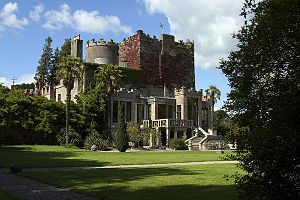Huntington Castle (Ireland)
| Huntington Castle | ||
|---|---|---|
|
Huntington Castle |
||
| Alternative name (s): | Clonegal Castle | |
| Creation time : | 17th century | |
| Castle type : | Niederungsburg | |
| Conservation status: | well preserved | |
| Standing position : | Irish nobility | |
| Construction: | Quarry stone | |
| Place: | Clonegal | |
| Geographical location | 52 ° 41 '25.4 " N , 6 ° 38' 56.6" W | |
| Height: | 57 m ASLTemplate: height / unknown reference | |
|
|
||
Huntington Castle , also Clonegal Castle , Irish Caisleán Chluain na nGall , is a castle in the village of Clonegal in Irish County Carlow .
The building was originally a "Plantation Castle" which served as a defensive structure for the area in the plantation period at the beginning of the 17th century. The original Tower House , which housed a garrison, was built in the 15th century as a fortress of the Caviness , an ancient Irish clan, later Barons Esmonde . Because of the strategic importance of the village Clonegal during the Cromwellian conquest of Ireland , which in its location on the road from Dublin to Wexford was founded, the castle was built by the troops of Oliver Cromwell's taken, as this 1650 to Kilkenny marched.
Huntington Castle is now privately owned, but open to the public on guided tours in June, July, August, and September. There Stanley Kubrick's film Barry Lyndon was shot. The base of a religious sect, the Fellowship of Isis , has been in the basement since 1976 . The Solas Festival took place in the castle in August 2008 and was co-founded by Olivia Robertson , her brother Lawrence Durdin-Robertson and his wife Pamela .
Gardens
The Esmonde family laid out most of the gardens in the 17th century. They include the French lime tree avenue , the parterre and the meadows to the side of the castle, the fish ponds on both sides of the middle path through the natural garden and most of the yew trees that make up the Yew Walk . The large plantings have resulted in a number of great Irish trees growing at Huntington Castle, such as: B. Different varieties of hickories , English oaks , cherry apples and horse chestnuts . A lake below in the natural garden was created for decorative purposes, but nearby is one of Ireland's first water turbine houses , which supplied Huntington Castle with its own electrical power as early as 1888. The River Derry , which forms the border between Counties Wexford and Carlow, flows along the lower boundary of the natural garden and forms a beautiful setting for the walks through the light forest.
Ghosts
Myths abound that Huntington Castle was haunted by ghosts of druids , in the fields and even in the castle itself. It is said that the druids could create mist in a second, start a fire with their will And rain blood They were feared because they sacrificed men and women to please their gods. There is also a fountain in the castle that never runs dry. Therefore, this fountain has often saved the castle from sieges.
Individual evidence
- ↑ Jeremy Williams: A Companion Guide to Architecture in Ireland 1837-1921 . Irish Academic Press, 1994. ISBN 0-7165-2513-5 . P. 39.
- ^ A b Marianne Heron: The Hidden Houses of Ireland . Gill & Macmillan, 1999. ISBN 0-7171-2730-3 . Pp. 28-30.
- ^ Suzanne Rowan Kelleher: Frommer's Ireland 2004 . Issue 14. John Wiley and Sons, 2004. ISBN 978-0-764542-16-9 . P. 177.
- ↑ Pamela Newenham: Bad weather, mess and muck 'but the vibe was great' . In: Irish Times . August 18, 2008. Retrieved April 26, 2018.

